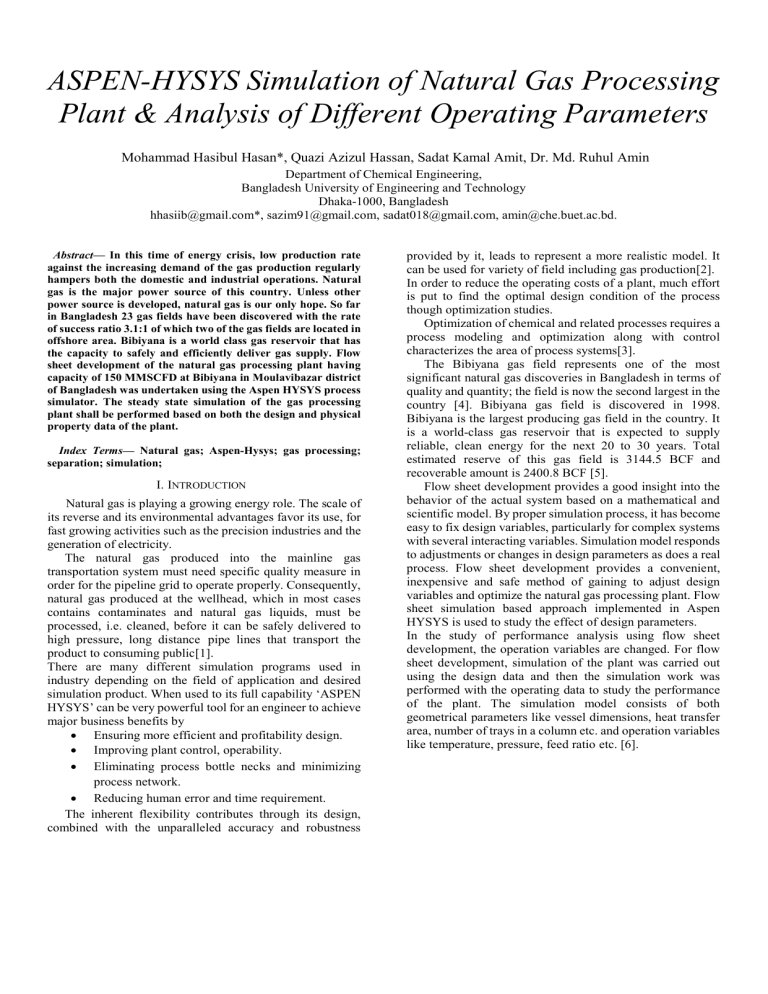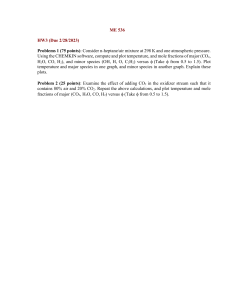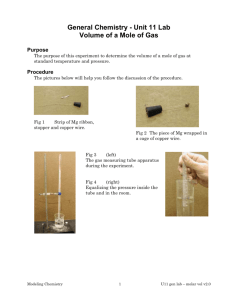
ASPEN-HYSYS Simulation of Natural Gas Processing Plant & Analysis of Different Operating Parameters Mohammad Hasibul Hasan*, Quazi Azizul Hassan, Sadat Kamal Amit, Dr. Md. Ruhul Amin Department of Chemical Engineering, Bangladesh University of Engineering and Technology Dhaka-1000, Bangladesh hhasiib@gmail.com*, sazim91@gmail.com, sadat018@gmail.com, amin@che.buet.ac.bd. Abstract— In this time of energy crisis, low production rate against the increasing demand of the gas production regularly hampers both the domestic and industrial operations. Natural gas is the major power source of this country. Unless other power source is developed, natural gas is our only hope. So far in Bangladesh 23 gas fields have been discovered with the rate of success ratio 3.1:1 of which two of the gas fields are located in offshore area. Bibiyana is a world class gas reservoir that has the capacity to safely and efficiently deliver gas supply. Flow sheet development of the natural gas processing plant having capacity of 150 MMSCFD at Bibiyana in Moulavibazar district of Bangladesh was undertaken using the Aspen HYSYS process simulator. The steady state simulation of the gas processing plant shall be performed based on both the design and physical property data of the plant. Index Terms— Natural gas; Aspen-Hysys; gas processing; separation; simulation; I. INTRODUCTION Natural gas is playing a growing energy role. The scale of its reverse and its environmental advantages favor its use, for fast growing activities such as the precision industries and the generation of electricity. The natural gas produced into the mainline gas transportation system must need specific quality measure in order for the pipeline grid to operate properly. Consequently, natural gas produced at the wellhead, which in most cases contains contaminates and natural gas liquids, must be processed, i.e. cleaned, before it can be safely delivered to high pressure, long distance pipe lines that transport the product to consuming public[1]. There are many different simulation programs used in industry depending on the field of application and desired simulation product. When used to its full capability ‘ASPEN HYSYS’ can be very powerful tool for an engineer to achieve major business benefits by Ensuring more efficient and profitability design. Improving plant control, operability. Eliminating process bottle necks and minimizing process network. Reducing human error and time requirement. The inherent flexibility contributes through its design, combined with the unparalleled accuracy and robustness provided by it, leads to represent a more realistic model. It can be used for variety of field including gas production[2]. In order to reduce the operating costs of a plant, much effort is put to find the optimal design condition of the process though optimization studies. Optimization of chemical and related processes requires a process modeling and optimization along with control characterizes the area of process systems[3]. The Bibiyana gas field represents one of the most significant natural gas discoveries in Bangladesh in terms of quality and quantity; the field is now the second largest in the country [4]. Bibiyana gas field is discovered in 1998. Bibiyana is the largest producing gas field in the country. It is a world-class gas reservoir that is expected to supply reliable, clean energy for the next 20 to 30 years. Total estimated reserve of this gas field is 3144.5 BCF and recoverable amount is 2400.8 BCF [5]. Flow sheet development provides a good insight into the behavior of the actual system based on a mathematical and scientific model. By proper simulation process, it has become easy to fix design variables, particularly for complex systems with several interacting variables. Simulation model responds to adjustments or changes in design parameters as does a real process. Flow sheet development provides a convenient, inexpensive and safe method of gaining to adjust design variables and optimize the natural gas processing plant. Flow sheet simulation based approach implemented in Aspen HYSYS is used to study the effect of design parameters. In the study of performance analysis using flow sheet development, the operation variables are changed. For flow sheet development, simulation of the plant was carried out using the design data and then the simulation work was performed with the operating data to study the performance of the plant. The simulation model consists of both geometrical parameters like vessel dimensions, heat transfer area, number of trays in a column etc. and operation variables like temperature, pressure, feed ratio etc. [6]. II. NATURAL GAS PROCESSING Natural-gas processing is a complex industrial process designed to clean raw natural gas by separating impurities and various non-methane hydrocarbons and fluids to produce what is known as pipeline quality dry natural gas [7]. Natural-gas processing begins at the well head. The composition of the raw natural gas extracted from producing wells depends on the type, depth, and location of the underground deposit and the geology of the area. Oil and natural gas are often found together in the same reservoir. The natural gas produced from oil wells is generally classified as associated-dissolved, meaning that the natural gas is associated with or dissolved in crude oil. Natural gas production absent any association with crude oil is classified as “non-associated” [8]. Most natural gas extracted from earth contains, to varying degrees, low molecular weight hydrocarbon compounds including methane (CH4), ethane (C2H6), propane (C3H8) and butane (C4H10). The natural gas extracted from coal reservoirs and mines (coal bed methane) is the primary exception, being essentially a mix of mostly methane and about 10 percent carbon dioxide (CO2) [9]. III. SIMULATION OF THE GAS PROCESS PLANT In this proposed plant there are five major units which will process the raw natural gas. These are: (1) separation unit, (2) dehydration unit & heat exchanger, (3) de-ethanizer and (4) final purification & CO2 removal units. A. Separation Unit In simulating the processing plant, gas is drawn from three wells: Well-1, Well-2 and Well-3 respectively. This data are chosen randomly. Due to limitation and industrial visit the used data are assumed. If the industrial data are obtained the simulation can be done with real plant data can be compared with ‘Bibiyana’ gas processing plant industry. Composition of the feed can be found in datasheet. Then the gas is passed through the pressure control valve to relief some pressure & then fed into three ‘3 phase separators’ (H-110A, H-110B, H110C) to separate each valve out stream in heavy liquid, light liquid & vapor streams. Most of the liquids are separated at this separation unit. The three heavy liquid streams (mostly H2O) are removed & the three light liquid streams are mixed together in a mixer & then entered into a distillation column (D-320) through an expansion valve, the bottom liquid product is liquefied petroleum gas (LPG) & is stored in a tank(F-210). The overhead product of D-320 is mixed with refined gas stream to prepare the very final product. B. De-hydration Unit & Heat-Exchanger Unit The three vapor streams of the separators are mixed in a mixer & passed through the dehydration unit for water removal. The dehydration unit consists of an absorption tower (D-310) where TEGlycol is used as absorbent of water. The overhead vapor product (dehydrated hydrocarbons) of (D-310) is passed through two heat exchangers (E-230) & (E250) & temperature is decreased. The tube out of E-250 heat exchanger is then entered into a separator (H-140). Then expander (G-152) lowers streams temperature using JouleThomson principle of pressure relief & then three phase separator separates the remaining water in the mixed inlet more precisely. Heavy liquid is removed & light liquid (H150 liquid out) and vapor (H-150 vapor out) is used for further processing. On the other hand, bottom product of the absorption tower(D-310) is passed through an expansion valve (K-131) & a two phase separator(H-130) ,bottom product of which is used as a tube side inlet of heat exchanger (E-240). The tube side outlet is then entered into a column (D-330) whose bottom product is make-up Glycol solution & is entered into the shell side of the heat-exchanger (E-240) & heatexchanger (E-230). Between the heat-exchangers a pump is used to increase the pressure. The shell outlet of E-230 is mixed with TEGlycol feed to use in the absorption tower (D310). C. De-ethanizer Unit The liquid stream of the three phase separator(H-150) is then used in the de-ethanizer(distillation column D340).Bottom product of the column(D-340) is LPG & passed through the heat-exchanger(E-101) to prepare ‘Final LPG’ at low temperature. Stream (H-150 vapor out) is mixed with the over-head vapor product of (D-340). Mixed stream (M-231 out) is entered into the shell side of the heat exchanger (E250) to increase the temperature. D. Purification & CO2 removal Unit Stream (M-251 shell out) is then gone through CO2 removal process. In this stage we used principles of liquefaction to separate CO2. Using cooler, heat-exchanger, compressor & separator, CO2 from natural gas has been highly decreased(less than 0.03%). CO2 can also be removed using absorption process where ME-Amine solution is used to absorb CO2. We can also use selexol for physical absorption of CO2.. IV. PROCESS FLOW DIAGRAM (PFD) V. RESULTS AND DISCUSSIONS A. Product Composition Flow sheet development and design of natural gas processing plant using the Aspen HYSYS was undertaken. Flow sheet development was performed based on the design and operating data of the plant. The sales gas & LPG composition obtained from this processing plant are shown in Table 1 & Fig. 1 respectively. MOLE FRACTION OF METHANE IN PRODUCT 0.9652845 0.965284 0.9652835 0.965283 0.9652825 0.965282 0.9652815 TABLE 1. COMPOSITION OF SALES GAS 0.965281 Composition Name of Components Composition Water(H2O) 5.9×10-6 n-Heptane 7.09×10-5 N2 2.1×10-3 n-Octane 1.2×10-5 CO2 2.6×10-4 n-Nonane 2.8×10-6 -7 Methane 0.9957 n-Decane 5.3×10 Ethane -4 9.2×10 n-C11 1.3×10-7 Propane 2.6×10-4 n-C12 5.2×10-8 i-Butane 1.2×10-4 n-C13 1.5×10-8 n-Butane 1.6×10-4 n-C14 9.8×10-9 i-Pentane 1.7×10-4 TEGlycol 4.05×10-23 n-Pentane 1.03×10-4 MEAmine 0 n-Hexane 6.8×10-5 LPG Composition 7% 24% 14% 10% 14% 6% 9% 16% Propane i-Butane n-Butane i-Pentane n-Pentane n-Hexane n-Heptane Others 0.9652805 0 20 40 60 NO OF STAGES Fig. 2. Graph of mole fraction of CH4 vs No of stages From Fig. 2 it is shown in the graph that as the no of stages get increased the mole percentage of CH4 gets increased. Usually greater the no of stages, more the contact between vapor and liquid phase and more the separation can be done. But in case of building distillation column the point that should be in consideration is the cost of building and maintenance. So, for minimizing the cost of production and optimizing the amount of CH4 produced the design parameter need to be determined. PRESSURE IN G-152 COMPRESSOR (KPA) Name of Components 6000 5000 4000 3000 2000 1000 0 0.963 0.9635 0.964 0.9645 0.965 0.9655 MOLE FRACTION OF METHANE IN PRODUCT Fig. 3. Graph of pressure in compressor vs mole fraction of CH4 Fig. 1. Composition of LPG B. Graphical Representation For the process described, varying the value of different variable their corresponding data were generated and relevant curves were plotted. It is noted from the Fig. 3 that as the pressure of the compressor G-152 get increased the composition of methane in product got decreased. But it is required to compress the gas to separate the other components from the stream. The compressed gas is later sent to 3-phase MOLE FRAACTION OF PROPANE IN LPG separator in which the pressure impact is resulting the separation of desired product from other elements. MOLE FRACTION OF METHANE IN PRODUCT 0.965285 0.965284 0.965283 0.965282 0.965281 0.96528 0.2375 0.237 0.2365 0.236 0.2355 0.235 0.2345 0.234 0.2335 0.233 0 0.965279 5 10 15 FEED STAGE OF DISTILLATION COLOUMN D-340 0.965278 0 5 10 NO OF FEED STAGE IN D-340 DISTILLATION COLOUMN 15 Fig. 4. Graph of mole fraction of CH4 vs feed stage no. in distillation column From Fig. 4 it is noticed from the curve that mole fraction of CH4 get increased as the no of feed stage get increased. At some point some consistency is shown. As the no of feed stage becomes larger the contact time for liquid and vapor phase in distillation column get increased thus the output percentage get larger. MOLAR FLOW OF CO2 IN PRODUCT (KGMOL/HR) 12 10 Fig. . Graph of C3H8 in LPG vs feed stage in distillation column D340 From the Fig. we can see that with the increased number of feed stage in D-340 distillation column, the propane recovery in LPG becomes higher. This is because the less the feed stage number is, the more the efficiency of the column will be as there will be increased amount of contact and heat transfer. As a result propane becomes more in liquid form. This curve justifies theoretical curve. C. Product Comparison between Our Simulated Plant data & Different Natural Gas Processing Plants Methane composition, Carbon-Di-Oxide content & specific gravity of our simulated sales gas product & existing different gas processing plants are shown comparatively in Fig. 6, 7 and 8 respectively. Here, the term, ‘experimental’ represents our simulated data. 8 Methane Composition Comparison 6 4 2 0 -185 -165 -145 -125 -105 OUTLET TEMPERATURE OF HEATER E- -85 100 98 96 94 92 90 ᴼC Fig. . Graph of molar flow rate of CO2 vs heater outlet temp Fig. . Comparison of Methane composition Due to cooling by unit E-100 the percentage of CO2 along with CH4 get increased in product as shown by the plot. It’s because the separation process of CH4 from CO2 can’t be attain by varying temperature. Thus using some adsorbent to absorb the amount of CO2 need to be removed can be a better approach shows that the methane composition of our Figure experimental sales gas product is higher than that of different gas processing plants of our country. We know, natural gas is mainly methane [11]. Methane composition is a parameter which denotes natural gas product quality [12]. In this regard ours’ is better. Carbon Di Oxide Content Comparison 0.6 0.4 0.2 0 0.6 0.47 0.0003 0.07 0.11 0.15 processing plant is developed in this paper. Different process can be used to meet the specification required for processing of natural gas. Environmental constraints and the need to reduce cost require innovative processes. The process used here derived from earlier processes, but tend to offer significant reductions in investment and operating costs. In the longer term, new concepts such as gas permeation can be expected to play a growing role and the natural gas processing will keep changing. In these plan, the composition of sales gas satisfactory. The percentage removals of unwanted elements are good enough to run the process. ACKNOWLEDGMENT Fig. . Carbon-Di-Oxide content comparison CO2 removal is another pre-requisite in natural gas processing plant [13]. Presence of CO2 content can cause corrosion, undesired hydrate formation and severe problem in cryogenic process [14]. So, the lesser the CO2 content, the better. From Fig. we find the CO2 content of experimental value is less than other NG processing plants of our country. Specific Gravity Comparison 0.62 0.6 0.58 0.56 0.54 Fig, . Specific gravity comparison From Fig. it is found that, the specific gravity of the product natural gas of our experiment is similar to the different gas processing plants of our country. All of them range between 0.54 & 0.60. VI. CONCLUSION At present time natural gas is a major source of energy. Most of the industries are run by energy using natural gas as their main source. Near about 95% of the natural gas is used as fuel gas. So, it is a major prospect to focus on and develop for the betterment of energy utilization. The model for natural gas The work is supervised by Dr. Md. Ruhul Amin. We are very grateful for his kind assistance. The technical and administrative backup given by the Department of Chemical Engineering, BUET is highly valuable and we are very thankful to the department also. REFERENCES 1 Arthur J. Kidnay, W.R.P., Fundamentals of Natural Gas Processing. 2006, USA: CRC Press. 418. 2 M., P.S.R.a.R.A., Aspen-HYSYS Simulation of Natural Gas Processing Plant. Journal of Chemical Engineering, IEB, 2011. Vol. ChE. 26(1): p. 4. 3 Saeid Mokhatab, W.A.P., Handbook of Natural Gas Transmission and Processing. 2nd ed. 2006, UK: Elsevier science limited. 4 Zahir Ahmed, M.R., Fatem Bashar and Katy Gardner, Bibiyana: Local Livelihoods, Poverty and the Gas Fields Some Initial Findings. 5 Chowdhury, Z., , Natural Gas Reserve Estimate of Bangladesh. 6 Chandra, V., Fundamentals of Natural Gas: An International 2006, USA: PennWell Corporation. 169. 7 Kelkar, M., Natural Gas Production Engineering. 2008, USA: PennWell Corporation. 8 Gene Whitney, C.E.B., Energy: Natural Gas: The Production and Use of Natural Gas, Natural Gas 2010, USA: The Caitol.Net,Inc. 9 Robert Hubbard, U.o.O., The Role of Gas Processing in the Natural-Gas Value Chain. 2009: p. 7. 10 Saeid Mokhatab, J.Y.M., Jaleel V. Valappil, David A. Woo, Handbook of Liquefied Natural Gas. 2014, UK: Elsevier Inc. [11] Salvo, J.M., DETERMINING NATURAL GAS QUALITY PARAMETERS EXPRESSED IN VOLUME. [12] Biruh Shimekit, H.M., Natural Gas Purification Technologies – Major Advances for CO2 Separation and Future Directions, in Advances in Natural Gas Technology, D.H. Al-Megren, Editor. 2012, In Tech: Malaysia. p. 542. [13] Kumar, S., Gas Production Engineering. Vol. 04. 1987, Houston Texas: Gulfs Publishing company.






